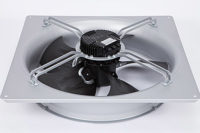Since the introduction of Electrically Commutated Motors (ECMs) over fifty years ago, there has not been a substantial energy efficiency improvement in motor technology for commercial refrigeration applications that exceeds the current generation of available ECM products.
Generally considered to be today’s ‘state of the art’ solution, ECMs are now the standard motor used by most OEM product designers for everything from commercial refrigeration fans to everyday consumer products. While there is no question that ECMs offer better efficiency than older motor designs, there is still plenty of room for improvement. The problem is that companies manufacturing motors in this space have made only incremental improvements throughout the years, consisting of better engineered circuits and materials to fix the previous SKUs design faults. A more advanced alternative motor design has not been available that can seriously challenge the status quo and shake up the motor industry, until now.
For years, the commercial refrigeration industry has predominantly had two primary choices for fan motors: the induction or shaded-pole motor invented by Nikola Tesla in the 1880s, and the Electronically Commutated Motor (ECM) developed in the 1960s. More than sixty-five percent of all commercial refrigeration motors deployed today are still shaded-pole motors, which are often twenty percent or less energy efficient. The ECM has approximately a thirty-five percent market share and is typically fifty to sixty percent efficient at 9-12 watt output when tested in the field.
For engineers and contractors working on the next generation of commercial refrigeration products, there is a rapidly emerging class of new, smart synchronous permanent magnet motors that has the potential to completely disrupt the ECM market in a big way. The smart synchronous permanent magnet motor design provides grocers, convenience stores, restaurants, and their OEMs, contractors, and utilities with a compelling new choice: a seventy-five percent efficient motor at 9-12 watts for approximately the same cost as an ECM.
As with most major advances in technology, most new inventions are later seen as obvious in hindsight. This new class of motors is no different. It utilizes a concept that is both simpler in its design, and vastly reduces the amount of energy consumed when compared to all motor types available on the market today.
Smart, Synchronous Motors
Smart Synchronous Motors are a permanent magnet motor with a circuit design that limits the need to manage energy draw beyond the initial motor startup. Whereas an ECM requires continual conversion between AC and DC power throughout its use to operate, the beauty and simplicity behind this new class of motors lies in its ability to operate at the AC line frequency of grid supplied power, essentially eliminating the need for power conversion after the motor starts (the need to rectify to DC and back to AC).
Once the motor reaches its targeted speed, it efficiently shifts the motor to AC power supplied directly from the grid. The elimination of the power conversions has been found to save in excess of 30% to 50% versus ECMs and about 80% versus shaded pole motors. The stability and performance of air flow in the refrigeration system is further improved by operating off the AC line frequency, because changes to voltage do not affect fan speed (which is the case with many ECMs).
Another benefit to this design is that reducing the amount of electronics and the duty cycle on the motor increases reliability while extending the life expectation of the motor. As a result, these motors have a much longer warranty period, often twice that of ECM alternatives. Furthermore, by eliminating the use of electronics during operation, any surges in the line would be absorbed by the coils, not the electronics.
Most critics tend to challenge the efficacy of any new technology claims before they have been tested outside of a controlled lab environment. The results of the first DOE demonstration were documented in a publication by Oak Ridge National Laboratory in September 2015 which found this new class of motors to have a significant energy savings over ECM motors, with the potential to reduce overall source energy consumption in the United States by as much as 300 billion kilowatt-hours or more with proportional environmental benefits.
“It’s Really About Airflow, Not RPM”
A common misconception about commercial refrigeration systems is that they need to be run at 1550 RPM, the speed commonly associated with a shaded pole motor. If you look at the history of shaded pole designs, 1550 RPMs are actually produced as a result of the inefficiencies caused by the motor “slip” from 1800 RPM to 1550 RPM. Since ECMs can be controlled to operate at any speed, many designers chose that speed to simplify the conversion to ECMs as a potential drop-in replacement.
Refrigeration systems typically are optimized for peak efficiency when a specific fixed airflow can be achieved by matching a specific motor speed with a specific pitch blade. Both motors and blades are typically designed to have a peak efficiency at only one point and have much lower efficiencies when operating off those optimized design points. With airflow requirements varying by case, OEM designers have typically chosen a fixed speed motor and then used different pitch blades to provide the desired airflows.
A more recent strategy ECM manufacturers are considering is to source one variable speed motor that uses a single fan blade to provide a variety of prospective airflows with less SKUs. This is primarily intended to reduce costs at the OEMs as the speed is still fixed before delivering to the end customer. End users are currently evaluating whether the prospective supply chain efficiencies would partially be overwhelmed by the additional operating costs they could incur due to the lower efficiencies of the motor running in the field.
Is the end of the ECM market inevitable?
As with any major advancement in design, OEMs must adapt by phasing out inefficient technologies in their products to keep pace with the adoption of the latest technology. In the United States, rising minimum efficiency standards set forth by the Department of Energy are mandating the push towards more efficient technology approximately every three years. Having a new class of motors that operate at a higher efficiency could accelerate or even encourage utilities and government entities across the globe to adopt a higher efficiency standard than ECMs can adhere to today.
For applications requiring a significant amount of variable speeds, the additional costs associated with multiple power conversions may not overwhelm the potential value proposition. On the other hand, in commercial refrigeration and HVAC markets, where fixed airflows are often preferred, one or multiple smart synchronous permanent magnet motor designs may likely be adopted more quickly than in other applications and could rapidly transition into other competitive market segments as the technology evolves.
What about the cost?
The newest technologies are typically the most expensive, which is why it often takes so long to drive adoption into the mainstream. In the case of the smart synchronous permanent magnet motor, the reduction of electronic circuitry to maintain the motor’s continuous operation and its simplistic design should keep the costs nearly the same as existing ECMs today.
How does an ECM manufacturer stay competitive when a more advanced technology is available? Many might argue that ECM manufacturers would be forced to lower the upfront cost. Unfortunately, when looking at the bigger picture, choosing a motor based on upfront or lowest cost can often times be misleading. The total cost of ownership must be a factor. For example, if this technology cost the same wholesale price as current ECM offerings, and saved as little as a few dollars a year over an estimated 10 year product lifespan, the impact it would have could make it nearly impossible for existing motor solutions to compete on price. Theoretically, ECM manufacturers could potentially even ‘give’ their product away for free and still not achieve the same total cost of ownership, extended life, and reliability benefits for end users as a smart synchronous permanent magnet design.
In Conclusion
Appliance manufacturers and other OEMs have been gradually and steadily replacing incumbent AC motors with ECMs in a market that is expected to grow from $99.85 billion in 2014 to $141.7 billion by 2022 according to a report from Grand View Research. (www.grandviewresearch.com/industry-analysis/electric-motor-market)
The market will expand further as ECMs are replaced by even more cost-competitive, efficient technologies such as the smart synchronous permanent magnet motor.
With minimum efficiency regulations expected every three years on each appliance, the choices engineers make today could drive significant cost out of designs now and well into the future, and make it possible to avoid or skip the need for a whole redesign cycle altogether.






